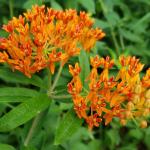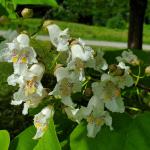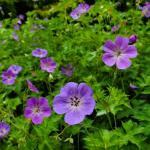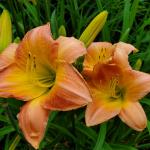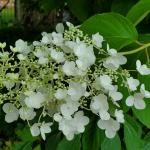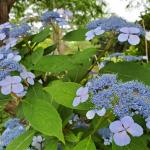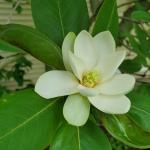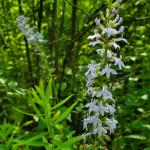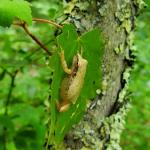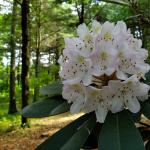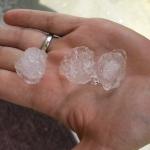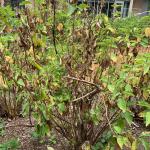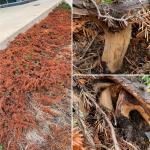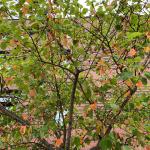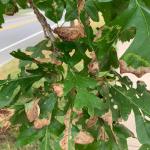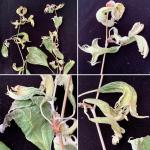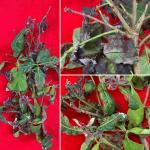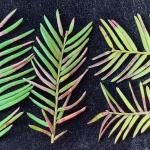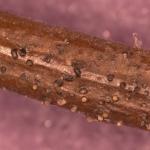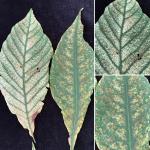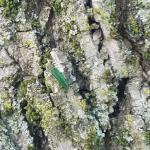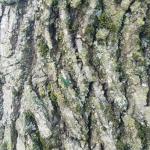UMass Extension's Landscape Message is an educational newsletter intended to inform and guide Massachusetts Green Industry professionals in the management of our collective landscape. Detailed reports from scouts and Extension specialists on growing conditions, pest activity, and cultural practices for the management of woody ornamentals, trees, and turf are regular features. The following issue has been updated to provide timely management information and the latest regional news and environmental data.
The UMass Plant Diagnostic Laboratory has reopened for plant disease, insect pest and invasive plant/weed samples. At this time, we can only accept mail-in samples, walk-in samples cannot be accepted. Please refer to our website for instructions on sample submission and to access the submission form: https://ag.umass.edu/services/plant-diagnostics-laboratory. Mail delivery services and staffing have been altered due to the pandemic, so please allow for some additional time for samples to arrive at the lab and undergo the diagnostic process. We look forward to resuming activities and diagnosing your plant problems!
The UMass Soil & Plant Nutrient Testing Lab is now accepting new orders for routine soil analysis and particle size analysis orders ONLY. Please do not send orders for other types of analyses at this time. Orders should be sent via USPS, UPS, FedEx or other private carrier. The lab office will remain closed to the general public until further notice and hand delivered orders will not be accepted at this time. Processing time will be longer than usual since the lab is operating with reduced staff and staggered shifts. Updates and order forms are available at: https://ag.umass.edu/services/soil-plant-nutrient-testing-laboratory.
Pesticide License Exams - The MA Dept. of Agricultural Resources (MDAR) has begun opening dates to hold exams for new exam applicants. Individuals will be able to begin signing up for new exams beginning 7/9/20. Exams will be held at the Colonial Inn in Gardener under a covered tent and safety precautions will be sent to the examinees ahead of time so that they can be prepared when coming to the exam site. Please be aware that space is still limited. To register, go to https://www.mass.gov/pesticide-examination-and-licensing.
For our COVID-19 Information and Support for Landscapers, Nurseries, Turf Managers, Garden Centers, Arborists, and Greenhouse Operations in Massachusetts, go tohttps://ag.umass.edu/landscape/news/covid-19-information-support-for-landscapers-nurseries-turf-managers-garden-centers.
To read individual sections of the message, click on the section headings below to expand the content:
Scouting Information by Region
Environmental Data
The following data was collected on or about July 8, 2020. Total accumulated growing degree days (GDD) represent the heating units above a 50° F baseline temperature collected via our instruments for the 2020 calendar year. This information is intended for use as a guide for monitoring the developmental stages of pests in your location and planning management strategies accordingly.
|
MA Region/Location |
GDD |
Soil Temp |
Precipitation
|
Time/Date of Readings |
||
|
2-Week Gain |
2020 Total |
Sun |
Shade |
|||
|
CAPE |
280 |
855 |
74 |
69 |
1.31 |
12:00 PM 7/8 |
|
SOUTHEAST |
309 |
974 |
86 |
73 |
0.90 |
3:30 PM 7/8 |
|
NORTH SHORE |
279 |
955 |
69 |
63 |
1.03 |
4:40 PM 7/8 |
|
EAST |
312 |
1046.5 |
77 |
74 |
4.40 |
5:00 PM 7/8 |
|
METRO |
307.5 |
1001.5 |
70 |
65 |
1.69 |
6:00 AM 7/8 |
|
CENTRAL |
301 |
1002 |
67 |
62 |
2.24 |
7:15 AM 7/8 |
|
PIONEER VALLEY |
302.5 |
1019 |
74 |
66 |
4.21 |
10:00 AM 7/8 |
|
BERKSHIRES |
280.5 |
917.5 |
73 |
67 |
3.25 |
7:30 AM 7/8 |
|
AVERAGE |
296 |
971 |
74 |
67 |
2.38 |
_ |
|
n/a = information not available |
||||||
Released on 7/9 , this map of MA shows only two counties free of "Moderate Drought" (D1) or "Abnormally Dry" (D0) conditions: https://droughtmonitor.unl.edu/CurrentMap/StateDroughtMonitor.aspx?MA
To track water use restrictions/bans by town, regularly check the MassDEP map: https://www.mass.gov/doc/water-use-restrictions-map/download
Phenology
| Indicator Plants - Stages of Flowering (BEGIN, BEGIN/FULL, FULL, FULL/END, END) | ||||||||
|---|---|---|---|---|---|---|---|---|
|
PLANT |
CAPE |
SE |
NS |
EAST |
METRO |
CENT |
PV |
BERK |
|
Buddleia davidii (butterfly bush) |
* |
* |
* |
* |
Begin |
* |
Begin |
* |
|
Oxydendron arboreum (sourwood) |
Begin |
* |
Begin |
Begin |
Full |
Begin/Full |
Full |
* |
|
Tilia cordata (littleleaf linden) |
Begin |
* |
Begin |
Full |
Full |
* |
Full |
Begin/Full |
|
Campsis radicans (trumpet vine) |
Begin |
Full |
Begin |
Begin |
Full |
* |
Full |
Begin |
|
Koelreuteria paniculata (goldenrain tree) |
* |
* |
Begin |
Begin |
* |
* |
* |
* |
|
Hydrangea macrophylla (bigleaf Hydrangea) |
Begin/Full |
Begin/Full |
Begin/Full |
Full |
Full |
Full |
Full |
Begin/Full |
|
Hydrangea arborescens (smooth Hydrangea) |
Full |
Full |
Full |
Full |
Full |
Full |
Full |
Full |
|
Rhus typhina (staghorn sumac) |
Full |
Full |
Full |
Full |
Full |
Begin/Full |
Begin/Full |
Full |
|
Itea virginica (Virginia sweetspire) |
Full/End |
* |
Full/End |
End |
Full/End |
Full/End |
Full/End |
Full/End |
| * = no activity to report/information not available | ||||||||
Regional Notes
Cape Cod Region (Barnstable)
General Conditions: The average temperature for the period from June 24 thru July 8 was 70˚F with a high of 85˚F on June 25 and a low 57˚F on July 6. Overall the period was dominated by cloudy and overcast days with highs in the 70s, lows in the 60s. During the period 1.31 inches of precipitation fell in showers or thunderstorms spread across several days. The precipitation was very much needed and provided a slight relief for plants from the overall dry conditions that have dominated the spring and early summer. Topsoil moisture and subsoil moisture remain short.
Pests/Problems: Insects or insect damaged observed during the period include Japanese, Oriental and Asiatic beetles which are all active as adults, Hibiscus sawfly damage on hardy Hibiscus, Andromeda lacebug on Andromeda, azalea lacebug on PJM Rhododendron, black turpentine beetle on pitch pine, and eriophyid mites on black cherry and linden. Lecanium scale is just beginning to hatch but they have not yet begun to migrate to the leaves and remain protected under the helmet shaped bodies of dead females. Disease symptoms and signs observed over the period include apple scab and cedar apple rust on crabapple, powdery mildew on Phlox, rust on hemlock, leaf spot on Heritage birch and cercospora leaf spot on bigleaf Hydrangea. Leaf curling and scorch can be seen on water stressed woody plants such as dogwood and unirrigated lawns are in drought/summer dormancy. Weeds in bloom includewhite clover (Trifolium repens), yellow wood sorrel (Oxalis stricta), fleabane (Erigeron annuus), and sheep sorrel (Rumex acetosella). Lots of rabbits are around. Keep yourself protected from ticks!
Southeast Region (Dighton)
General Conditions: Haze, heat and humidity were the weather bywords over the last two weeks. Mushrooms and fungus problems were apparent on lawns. Despite the humidity we have had precious little rain. Among the plants flowering were: Lysimachia clethroides (gooseneck loosestrife), Hypercium preforatum (Saint John's wort), Achillea millefolium (yarrow), Hemerocallis spp. (daylily), Lilium spp. (Asiatic lily), Aesculus parviflora (bottlebrush buckeye), Rhododendron viscosum (swamp white azalea), Nepeta spp. (catnip), Rosa spp. (rose), Monarda didyma (scarlet beebalm), Phlox paniculata (garden Phlox), Campanula rapunculoides (creeping bellflower), Asclepias incarnata (swamp milkweed), A. syriaca (common milkweed), Yucca filamentosa (Yucca), Opuntia spp. (prickly pear cactus), Daucus carota (Queen Anne's lace), Cornus racemosa (gray dogwood), Rudbeckia hirta (black-eyed-Susan), Sambucus canadensis (elderberry), Coreopsis spp. (tickseed), Hosta spp. (plantain lily), Astilbe spp. (false Spirea), Viola tricolor (Johnny-jump-up), Castanea mollissima (Chinese chestnut), Oenothera macrocarpa (Ozark sundrop/Missouri evening primrose), Rhus typhina (staghorn sumac), Stewartia pseudocamellia (Stewartia), Salvia nemerosa (woodland sage/Balkan clary), Stachys byzantina (lamb’s-ear), Campsis radicans (trumpet vine), Lonicera sempervirens (coral honeysuckle/trumpet honeysuckle), L. japonica (Japanese honeysuckle), Hydrangea quercifolia (oakleaf Hydrangea), H. paniculata (lacecap Hydrangea), Tradescantia spp. (spiderwort), Echinacea spp. (coneflower), Ligustrum ovalifolium (Korean privet), Linaria vulgaris (toadflax/butter n’eggs), Erigeron annuus (fleabane), Lythrum salicaria (purple loosestrife), and Liatris spicata (dense blazing star/prairie gayfeather).
Pests/Problems: Both Asiatic Garden Beetle and Oriental Beetle adults are flying. Also observed in the landscape were wind-distributed Fall Webworm caterpillars, settled Juniper Scale on J. chinensis 'Grey Owl', and red-thread on a newly established lawn. Where present, crabgrass has tillers and is making gains on drought stressed turf. Triple E has been found in Franklin County already. This is early and does not bode well with regard to infection rates in mosquitoes this season, but only time will tell. Often overlooked as hazardous are open containers of standing water that breed mosquitoes. You can do yourself and your clients a good turn by seeing that these are drained or treated while doing maintenance chores. Drains and cisterns can be hidden sources that are more likely to breed mosquitoes, especially during these times of infrequent rains which would normally flush them out.
North Shore (Beverly)
General Conditions: This reporting period saw the end of June and the first week of July. June was unusually dry with only 0.63 inches of rain recorded at Long Hill during the month. During the past two weeks a few fast moving storms passed through and dropped approximately 1.03 inches of rain during this period. The weather conditions during this period were mostly hot and humid with partial sunlight and overcast skies. The average daily temperature for this period was 69℉ with the maximum temperature of 87℉ recorded on July 8 and the minimum temperature of 59℉ recorded on July 7. Woody plants seen in bloom include: Virginia sweetspire (Itea virginica), oakleaf Hydrangea (Hydrangea quercifolia), big leaf Hydrangea (Hydrangea macrophylla), smooth leaf Hydrangea (Hydrangea arborescens), Japanese Hydrangea vine (Schizophragma hydrangeoides), summer blooming Spiraea (Spiraea japonica), staghorn sumac (Rhus typhina), tree false Spirea (Sorbaria arborea), Amur maackia (Maackia amurensis) and littleleaf linden (Tilia cordata). Herbaceous plants seen in bloom include: trumpet vine (Campsis radicans), summer flowering roses (Rosa spp.), Clematis vines (Clematis paniculata), foxglove (Digitalis purpurea), goat’s beard (Aruncus dioicus), ox-eye daisy (Leucanthemum vulgare), shasta daisy ((Leucanthemum x superbum), yarrow (Achillea spp.), catmint (Nepeta cataria), snakeroot (Actaea spp.), daylilies (Hemerocallis spp.), Hostas, Astilbes and an assortment of annuals.
Pests/Problems: Deer browsing continues to be observed on Hosta and some of the shrubs. The rains received in the last few days helped but they were not enough to alleviate the drought conditions. Turf on droughty and exposed lawns is brown and needs more rain to start growing again. Mountain laurel leaf blight was noted on recently planted shrubs. Leaf spots were observed on many plants. Japanese beetles were seen causing damage on some plants. Remember that ticks and mosquitoes are still very active. Take measures to protect yourself while working outdoors, especially at dawn or dusk. If you find a tick on yourself or on your dog please submit it by mail to UMass Laboratory of Medical Zoology (https://www.tickreport.com/) to find out if it is infected with any tick-borne disease pathogens.
East Region (Boston)
General Conditions: We have experienced typical July hot and humid days with a threat of thundershowers over the past two weeks. High temperatures ranged from 72˚F to 95˚F averaging 84˚F. We reached temperatures in the 90’s on two occasions, hitting 95˚F and 92˚F on July 2 and July 5 respectively. Low temperatures have been consistent over the past two weeks ranging from 60˚F to 65˚F, averaging 62˚F. We gained 322.5 GDD’s bringing the total to 1046.5. Precipitation has been inconsistent depending on your location. The majority of the Boston area received beneficial rain on June 28 with severe thunderstorms and 3.7” of precipitation. Another significant storm developed on July 5 delivering 0.4” of rain overnight. Many plants appear to have put on a growth spurt. Hydrangeas are flourishing and dominate the urban landscape with color from white, pink and purple to blue.
Pests/Problems: Japanese knotweed (Fallopia japonica) is towering over wooded roadsides and waterways. Curly dock (Rumex crispus) tall flowering spikes have formed. The invasive mile-a-minute vine (Persicaria perfoliata) is climbing over vegetation in abandoned fields. Powdery mildew has been prevalent on dogwood, lilac and some honeysuckle vines. Cedar-quince rust, caused by the fungus Gymnosporangium clavipes, has infected the fruit of many ornamental Amelanchier with co-host junipers in the area, leaving the now inedible fruit looking like orange asteroids. Tree of Heaven (Ailanthus altissima) is flowering.
Metro West (Acton)
General Conditions: The temperatures for the past two weeks have been moderate with daytime temperatures in the 70s and 80s and nighttime temperatures in the 60s. A high temperature of 90°F on the 2nd and a low of 58°F on June 27th were recorded. Thunderstorms moved quickly through the area on 3 separate occasions bringing much needed rain but also some hail and strong winds. For June, the monthly average precipitation is 3.93” and only 1.87” of rain was recorded. For July, the monthly average precipitation is 4.07” and as of the 7th, a mere 0.47” of rain has been recorded for this month so far. Observed in some stage of bloom this past week were the following woody plants: Aesculus parviflora (bottlebrush buckeye), Buddleia sp. (butterfly-bush), Castanea mollissima (Chinese chestnut), Hydrangea arborescens (smooth Hydrangea), H. macrophylla (bigleaf Hydrangea), H. paniculata (panicle Hydrangea), H. quercifolia (oakleaf Hydrangea), Ligustrum spp. (privet), Oxydendron arboreum (sourwood), Potentilla fruiticosa (Potentilla), Rhododendron viscosum (swamp azalea), Rhus typhina (staghorn sumac), Rosa 'Knockout' (‘Knockout’ family of roses), Rosa rugosa (beach rose), Rosa spp. (rose), Spiraea japonica 'Alpina' (Daphne spirea), Stewartia psuedocamellia (Japanese Stewartia), Tilia cordata (littleleaf linden), and Weigela florida (old fashioned Weigela). Woody vines observed in bloom were: Campsis radicans (trumpet vine) and Clematis spp. (Clematis).
Contributing even more color and interest to the landscape are some flowering herbaceous plants including: Achillea millefolium (yarrow), Actaea matsumurae 'White Pearl' (Japanese bugbane), Allium spp. (ornamental flowering onion), Asclepias syriaca (common milkweed), A. tuberosa (butterfly weed), Astilbe spp. (false spirea), Campanula persicifolia (peach-leafed bell flower), C. takesimana ‘Elizabeth’ (bell flower), Chrysogonum virginianum (green and gold), Coreopsis spp. (tickseed), C. verticillata (threadleaf Coreopsis), Daucus carota (Queen Anne's lace), Gaillardia aristata (blanket flower), Geranium cantabrigiense 'Biokovo' and 'Cambridge' (hardy cranesbill), G. macrorrhizum (bigroot Geranium), G. sanguineum (cranesbill Geranium), G. ‘Johnson’s Blue’ (cranesbill), Hemerocallis fulva (orange daylily), H. 'Stella D'Oro', (daylily), H. spp. (daylily), Heuchera spp. (coral bells), Hosta spp. (plantain lily), Iris ensata (Japanese iris), Leucanthemum spp. (shasta daisy), Lilium spp. (lily), Lychnis coronaria (rose campion), Lysimachia clethroides (gooseneck loosestrife), Monarda didyma (bee-balm), Oenothera macrocarpa (Ozark sundrops), Nepeta spp. (ornamental catmint), Phlox paniculata (garden phlox), Rudbeckia fulgida var. sullivantii 'Goldsturm' (black-eyed Susan), Salvia nemerosa (woodland sage/Balkan clary), Sedum kamtschaticum (Russian stonecrop), Stachys byzantina (lamb’s ear), Thymus praecox (thyme), Tradescantia sp. (spiderwort), Veronica spp. (speedwell), Veronicastrum virginicum (Culver’s root), and Yucca filamentosa (Yucca).
Pests/Problems: Despite the recent rain events, the lack of any substantial rain continues to be of concern for not only this reporting area but for much of Massachusetts. According to the US Drought Monitor map released on July 9, the Metro West area (Middlesex County) continues to experience abnormally dry soil conditions to a moderate drought and the potential for impacts are the following: crop growth is stunted; fire danger is elevated; lawns brown; gardens begin to wilt; surface water levels decline and voluntary water conservation is requested. Communities have implemented water bans restricting outdoor water use. This is of particular concern for trees and shrubs in the landscape stressed by pests, diseases and past drought. Signs of stress are apparent on trees, including premature leaf drop and flagging foliage.
Central Region (Boylston)
General Conditions: The two-week period ending July 8 brought some welcome rain, and steamy, humid conditions typical for this time of year. Daytime maximum temperatures fluctuated tremendously, touching 90˚F, but also topping out at just above 70˚F on June 29. Although the rainfall was welcome, it came in the form of several severe storms. With soils as dry as they were and with the rain coming down hard and fast, much of it was lost to run off. Much of the region remains in moderate drought according to the U.S. Drought Monitor. Spotted in bloom during this period were countless ornamental plants, including: Asclepias incarnata (rose milkweed/swamp milkweed), A. syriaca (common milkweed), A. tuberosa (butterfly milkweed), Hemerocallis (daylilies), Hydrangea paniculata (panicle Hydrangea), H. quercifolia (oakleaf Hydrangea), H. serrata (mountain Hydrangea), Itea virginica (Virginia sweetspire), Lobelia spicata (spiked Lobelia), Magnolia virginiana (sweetbay Magnolia), Monarda ‘Jacob Cline’ (beebalm), Pycnanthemum muticum (broad-leaved mountain mint), Oxydendrum arboreum (sourwood), Rhododendron arborescens (smooth azalea), and Rhododendron maximum (great rosebay).
Pests/Problems: Evidence of drought stress is appearing on established landscape plants. Betula nigra ‘Cully’ (Heritage river birch), for example, dropped ⅓ to ½ of its foliage in one case. Foliar diseases have been limited this season; such as very little powdery mildew has been seen. Azalea leaf gall was noted during the reporting period on various azalea species. Asiatic beetles are prevalent but not abundant. Gypsy moth is present but sparse, causing very little damage to susceptible tree species. Cross-striped cabbage worm, which typically shows up in late summer, has been found in abundance on brassicas in the vegetable garden.
Pioneer Valley Region (Easthampton)
General Conditions: We’ve entered the heart of the summer in the Pioneer Valley with the passing of the Fourth of July holiday. After a painfully long dry stretch that lasted through May and nearly all of June, there have been regular showers and thunderstorms throughout the region since 6/27. At the Easthampton reporting gauge, >4″ of rain was recorded during a seven-day span (6/27 through 7/3). Two storms over that period, on 6/28 and 7/3, resulted in accumulations of 0.97″ and 1.87″, respectively. Some of the rainfall during this period resulted in only minor accumulations (i.e. <0.4″), while other fast-moving storms brought heavy downpours with significant runoff that was never absorbed. However, to receive roughly a month’s worth of rain in a week was exactly what the parched soils needed. Despite some of the water loss, subsurface soil moisture is approaching adequate at this time. Yet soils were so dry, that once it was primed, the water was quickly absorbed. Therefore, surface soils may be drying once again with warm temperatures and high humidity a regular occurrence. Despite a brief reprieve from supplemental watering, young plants and recent transplants should once again be closely monitored. One band of thunderstorms on Sunday, 6/28 resulted in large hail (pictured below) that did damage to trees, shrubs and agricultural crops in the area. Scattered high winds brought down limbs and isolated trees. Temperatures have oscillated between mild and hot while dew points have generally been high (>70°F on 7/2 & 7/3, for example), creating muggy and swampy conditions. While no great surprise, June precipitation was well below average according to the Northeast Regional Climate Center, which reported rainfall at only 25–50% normal through much of the tri-county region (http://www.nrcc.cornell.edu/services/blog/2020/07/01/index.html). The lingering effects of the dry conditions are still a concern after essentially two months of very limited rainfall. Stay up to date with water use restrictions by municipality by following the MassDEP Bureau of Water Resources site (https://www.mass.gov/doc/water-use-restrictions-map/download).
Pests/Problems: The recent rain and high humidity, in conjunction with periods of mild temperatures (especially overnight), created near ideal conditions for woody plant disease development. As a result, foliar blights, anthracnose and stem/branch cankering pathogens should become more prominent on the landscape in the coming weeks. The effects of the drought were on display across the UMass campus, especially for trees and shrubs predisposed by previous stresses. A planting of red-twig dogwoods (Cornus sericea) that were weakened from Botryosphaeria stem cankering were wilting badly from the combined effects of disease and drought (pictured below). Additionally, two large plantings of groundcover juniper (Juniperus) are exhibiting serious dieback with red-brown needles. While it’s been dry and the planting site is very exposed, junipers are hardy, drought-resistant plants. Closer examination revealed widespread bark stripping at the base, most likely by voles (pictured below). Crabapples and serviceberry continue to shed older, yellowing leaves (serviceberry pictured below). For crabapple and apples, early defoliation from apple scab continues to be the primary cause. For serviceberry, the issues may be related to drought and other diseases/pests. A severe case of oak leaf blister, caused by Taphrina caerulescens, was observed on two campus bur oaks (Quercus macrocarpa) (see photo). These trees were badly diseased in 2018 but had little to no damage in 2019.
Berkshire Region (Great Barrington)
General Conditions: Hazy, hot and humid was the order of the day over the past two weeks. Dehydration under such conditions should be a concern for those working outdoors. Frequent sips of water are advisable. The dry conditions which characterized much of May and June were partly remedied by a couple of significant rainfalls and some lighter deposits of moisture during this two-week reporting period. However, soil moisture evaporated quite rapidly under the driving forces of several days of sunny and windy weather. Still, plant growth for the most part seems unaffected, except for some annuals and certain plants in vegetable gardens. Growth of turfgrass was slow but steady, though too often growth of weeds was faster than that of the grass.
Pests/Problems: The two heavy downpours mentioned above were gully washers and resulted in some soil erosion. Where bare soil exists, these heavy downpours have the effect of altering soil structure. Even on gentle slopes, there are clear signs of soil erosion with very fine soil particles having moved downslope and accumulated in the slightest of depressions. This alters the physical structure of soil, leaving behind slopes devoid of some of the silt, clay, and fine organic components essential for holding plant nutrients and moisture. The very fine particles which accumulated downslope or in depressions will, upon drying, form a crusty layer which affects the future movement of water and oxygen into the root zone of plants growing there. Thus, it is important to maintain a cover of vegetation on slopes. Plant pests observed this week were Japanese beetles in abundance, Asiatic garden beetles, many leaf miner species, a few adult imported willow leaf beetles, elongated hemlock scale, and fall webworm. Evidence of birch leaf miner, i.e. excrement-loaded blotches on leaves of paper birch (Betula papyrifera), was found but no larvae were seen. Removing the epidermis of boxwood leaves revealed the presence of the tiny yellow/orange eggs of the boxwood leaf miner. No adults were observed. As such, this would be a good time to prune boxwoods but do not leave behind any of the egg-laden debris. Other than black spot on roses and scab on crabapples, diseases are not common. What is common is the chipmunk. The numbers are much greater than normal as last year was a mast year for the little critters. Their browsing on plants in landscapes and gardens has been a frequent complaint as has browsing of tender annuals and perennials by deer and woodchucks.
Regional Scouting Credits
- CAPE COD REGION - Russell Norton, Horticulture and Agriculture Educator with Cape Cod Cooperative Extension, reporting from Barnstable.
- SOUTHEAST REGION - Brian McMahon, Arborist, reporting from the Dighton area.
- NORTH SHORE REGION - Geoffrey Njue, Green Industry Specialist, UMass Extension, reporting from the Long Hill Reservation, Beverly.
- EAST REGION - Kit Ganshaw & Sue Pfeiffer, Horticulturists reporting from the Boston area.
- METRO WEST REGION – Julie Coop, Forester, Massachusetts Department of Conservation & Recreation, reporting from Acton.
- CENTRAL REGION - Mark Richardson, Director of Horticulture reporting from Tower Hill Botanic Garden, Boylston.
- PIONEER VALLEY REGION - Nick Brazee, Plant Pathologist, UMass Extension Plant Diagnostic Lab, temporarily reporting from Easthampton.
- BERKSHIRE REGION - Ron Kujawski, Horticultural Consultant, reporting from Great Barrington.
Woody Ornamentals
Diseases
2,4-D herbicide injury to London planetree (Platanus × acerifolia). Tree is approximately 30-years-old and is growing in a mulched bed on a front lawn with full sun and loam soils. A 2,4-D herbicide to control broadleaf weeds in adjacent lawn was applied in mid-May. Symptoms of herbicide injury subsequently developed and included bleached, distorted/curled and undersized foliage (see photos). Drift injury caused by 2,4-D herbicides can readily occur in landscape settings but exposed trees and shrubs usually outgrow the damage over time.
Anthracnose of white oak (Quercus alba) caused by Apiognomonia errabunda. Tree is approximately seven-years-old and has been present at the site for four years. The tree is growing in an open field setting with full sun and no supplemental irrigation. Anthracnose-like symptoms were observed in 2019 and cultural measures were undertaken to reduce inoculum (removed discard leaves) and improve vigor (fertilization). This season, symptoms of anthracnose again appeared (see photos) and included foliar lesions, wilted/collapsed foliage and stem cankering. The oak anthracnose pathogen was abundant on the blighted leaves and stems. Members of the white oak group are generally more susceptible to oak anthracnose in comparison to members of the red oak group.
Cryptocline needle blight, caused by Cryptocline taxicola, on yew (Taxus sp.). The tree is old, approximately 80- to 100-years, and resides in a foundation bed with compacted soils. Brown-colored needle lesions first appear (see photo), developing into blackened and wilted shoots over time. Fruiting bodies rupture through the upper surface of the needle (also pictured) to release large volumes of clear spores. While not a common pathogen, C. taxicola can cause significant damage to landscape yews, which have very few associated pests and pathogens.
Infestation of the spruce bud scale (Physokermes piceae) on Alberta spruce (Picea glauca 'Conica') and Bird’s Nest Norway spruce (Picea abies 'Nidiformis'). Both trees are >20-years-old and reside in landscape settings. The Alberta spruce receives full sun and is experiencing dieback on only one side of the canopy while the Birds Nest spruce receives half sun and overhead watering. Sooty mold growth on the latter spruce elicited attention by the submitting landscaper. The spruce bud scale is native in North America and has a broad host range among spruce species. However, in landscape settings, it’s most often found on white and Norway spruce, as illustrated here.
Diplodia shoot and needle blight, caused by Diplodia sapinea, on Adcock’s Dwarf Japanese white pine (Pinus parviflora 'Adcock’s Dwarf'). This dwarf tree is just shy of 30-years-old and growing in an arboretum setting with a mixture of sun and shade. Soils are loamy sand and no supplemental irrigation is provided. Needles are turning red and several branches have died. While Diplodia blight is not as common on five-needle pines, the pathogen has a very broad host range among landscape conifers.
Suspected case of apple mosaic virus (ApMV) on bottlebrush buckeye (Aesculus parviflora). Tree is approximately 15-years-old and one of 12 in a group planting at an arboretum, growing in a shaded setting with occasional drip irrigation provided. Bleaching and mottling of interveinal leaf sections (see photo) is present throughout the entire canopy but only this tree is symptomatic. ApMV is widespread in temperate areas and primarily infects rosaceous hosts. However, Aesculus is one of several non-rosaceous genera known to serve as a host. Infections result in reduced growth and yield for fruit-bearing trees, but the disease is not known to be lethal and natural spread is slow and very patchy.
Needle and stem blight of Siberian cypress (Microbiota decussata) caused by Phyllosticta and Kabatina. Plant is roughly 12-years-old and has been present for many years at the site. Conditions include shade with well-drained soils, which is appropriate for this plant. Last year, browning needles and dieback was observed, which continued into this year. Both of these fungal pathogens are common on Juniperus and Thuja, but very few disease records exist for Microbiota. The needles may have been predisposed by winter injury or drought stress.
Dogwood anthracnose, caused by Discula destructiva, on kousa dogwood (Cornus kousa) and flowering dogwood (C. florida f. rubra). The kousa dogwood is >15-years-old and grows in full sun with sandy, dry soils. This spring, it exhibited a sudden and dramatic decline that was not present in previous years. The DA pathogen was well distributed on the submitted stems. The flowering dogwood is >20-years-old and is growing in a shaded, northwest-facing bed with slightly compacted soils and drip irrigation. In addition to DA on the shoot tips, this tree also had a case of powdery mildew. Dogwood anthracnose is typically a serious disease for flowering dogwoods in landscape settings, especially those growing in shaded settings. For kousa dogwood, trees must be highly stressed for the pathogen to cause significant injury, in most cases.
Anthracnose of tricolor beech (Fagus sylvatica 'Tricolor') caused by Colletotrichum. This 20-year-old tree has been present at the site for 10 years and is growing in partial shade with drip irrigation. Each spring, leaves develop brown patches and become curled and wilted. Colletotrichum has a broad host range among deciduous hardwoods and even some conifers, causing leaf spots, blights and stem cankering. The damage varies significantly by host, site conditions and microclimate. The woolly beech aphid (Phyllaphis fagi) was also present, although damage from this pest is usually minor for mature beech in the landscape.
Report by Nick Brazee, Plant Pathologist, UMass Extension Plant Diagnostic Lab, UMass Amherst.
Insects
Did you miss the live broadcasts of UMass Extension’s Invasive Insect Webinar Series? No problem! View the archived recordings of all seven webinars here:https://ag.umass.edu/landscape/education-events/invasive-insect-webinars
Interesting Insects Reported or Seen Since the Last Landscape Message:
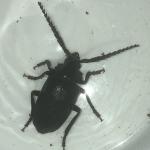 Broadnecked Root Borer: Prionus laticollis is a native beetle found from southeastern Canada and south to Georgia. These beetles are capable of killing trees and are among the largest of the North American beetles. Host plants growing in light or sandy soils are often the most damaged. The first symptoms of decline are smaller leaves that are lighter in color. This can progress to a thin leaf crown and twig dieback, and possibly death of the entire tree. All of the injury is caused by the larvae – the adults do not feed. To determine if larvae are damaging a host plant, the roots must be excavated and examined. Host plants include Malus, Tilia, Quercus, Populus, Prunus, Cornus, Acer, and Rhododendron. Some females of this species have reportedly laid up to 1200 eggs. Eggs are laid singly but deposited at the same general site in the soil or near partially exposed roots. Eggs are laid by the summer and larvae emerge by the late-summer, early-fall. Larvae will feed on the bark of a primary root and eventually enter the xylem. Small roots may be girdled or completely devoured. Larvae can then move through the soil to locate new roots. Galleries may be found in large roots and filled with wood chips and frass. Larval development can take 3-4 years. Pupation occurs in cells in the soil, just below the soil surface. Adult males fly and are attracted to lights at night whereas females have not been observed to fly. These native insects are more common to previously or otherwise weakened trees, so promoting tree health can help prevent an infestation. A common larval parasitic fly, Helicobia rapax, provides natural control. Lastly, this insect is sometimes confused for the Asian longhorned beetle. While it is also in the Family Cerambycidae, it is a native insect. For more information, visit:https://massnrc.org/pests/blog/?p=108
Broadnecked Root Borer: Prionus laticollis is a native beetle found from southeastern Canada and south to Georgia. These beetles are capable of killing trees and are among the largest of the North American beetles. Host plants growing in light or sandy soils are often the most damaged. The first symptoms of decline are smaller leaves that are lighter in color. This can progress to a thin leaf crown and twig dieback, and possibly death of the entire tree. All of the injury is caused by the larvae – the adults do not feed. To determine if larvae are damaging a host plant, the roots must be excavated and examined. Host plants include Malus, Tilia, Quercus, Populus, Prunus, Cornus, Acer, and Rhododendron. Some females of this species have reportedly laid up to 1200 eggs. Eggs are laid singly but deposited at the same general site in the soil or near partially exposed roots. Eggs are laid by the summer and larvae emerge by the late-summer, early-fall. Larvae will feed on the bark of a primary root and eventually enter the xylem. Small roots may be girdled or completely devoured. Larvae can then move through the soil to locate new roots. Galleries may be found in large roots and filled with wood chips and frass. Larval development can take 3-4 years. Pupation occurs in cells in the soil, just below the soil surface. Adult males fly and are attracted to lights at night whereas females have not been observed to fly. These native insects are more common to previously or otherwise weakened trees, so promoting tree health can help prevent an infestation. A common larval parasitic fly, Helicobia rapax, provides natural control. Lastly, this insect is sometimes confused for the Asian longhorned beetle. While it is also in the Family Cerambycidae, it is a native insect. For more information, visit:https://massnrc.org/pests/blog/?p=108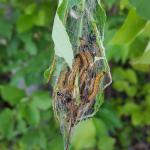
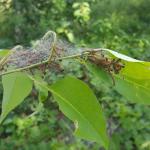 Cherry Web-Spinning Sawfly: A Neurotoma sawfly was observed feeding on cherry (Prunus spp.) in Chesterfield, MA on July 6, 2020. Caterpillars are a dull orange with dark bands and black heads. Caterpillars were seen feeding on cherry in clusters, webbing together foliage as they feed. Ample black frass pellets could be seen within the webbed pockets of leaves. Caterpillars in this genus feed on cherry, plum, peach, almond, and hawthorn in North America. At least five species in this genus are known to North America, including one introduced insect, N. edwardi. Females of this genus insert eggs singly or in groups on the underside of leaves along a leaf vein. After hatching, larvae spin webs of silk, including leaves and frass, within which they feed. Some species, such as the one pictured here, feed gregariously. Mature larvae drop to the ground where they burrow into the soil to overwinter. Pupation and adult emergence occurs in the spring. Species in this genus generally have one generation per year. More information about these insects can be found here: http://idtools.org/id/sawfly/factsheet.php?name=17158
Cherry Web-Spinning Sawfly: A Neurotoma sawfly was observed feeding on cherry (Prunus spp.) in Chesterfield, MA on July 6, 2020. Caterpillars are a dull orange with dark bands and black heads. Caterpillars were seen feeding on cherry in clusters, webbing together foliage as they feed. Ample black frass pellets could be seen within the webbed pockets of leaves. Caterpillars in this genus feed on cherry, plum, peach, almond, and hawthorn in North America. At least five species in this genus are known to North America, including one introduced insect, N. edwardi. Females of this genus insert eggs singly or in groups on the underside of leaves along a leaf vein. After hatching, larvae spin webs of silk, including leaves and frass, within which they feed. Some species, such as the one pictured here, feed gregariously. Mature larvae drop to the ground where they burrow into the soil to overwinter. Pupation and adult emergence occurs in the spring. Species in this genus generally have one generation per year. More information about these insects can be found here: http://idtools.org/id/sawfly/factsheet.php?name=17158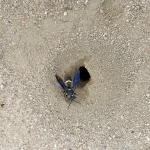
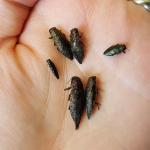 "Smokey Winged Beetle Bandit”: Cerceris fumipennis is a native, ground-nesting wasp that is excellent at finding buprestid beetles, or the jewel beetles, including our own native species as well as the invasive emerald ash borer. The female wasps will collect these jewel beetles and provision their own individual (although aggregated) subterranean nests with paralyzed beetles on which they will lay an egg. Although these wasps are not able to decrease the emerald ash borer population in the state, they can be used as a monitoring tool with a technique known as biosurveillance. These wasps nest in hard-packed, sandy soils in full sunlight, such as those found in baseball diamonds and along dirt roads. These wasps, although large, are incapable of stinging people. They can be distinguished from other ground-nesting wasps that might offer a painful sting by their black body with a single yellow band on the abdomen and yellow spots on the head (3 on the females, 2 on the males) and their blue-black iridescent wings. The openings to their nests are about the thickness of a pencil and often have a buildup of sand in a mound around them, known as a tumulus. Sometimes jewel beetles (including the emerald ash borer) can be found on the ground, scattered between the groups of nests. If you find these wasps nesting in a ballfield or other such area, there is no need to remove them or kill them (no one will get stung). So please, help preserve this wonderful native insect!
"Smokey Winged Beetle Bandit”: Cerceris fumipennis is a native, ground-nesting wasp that is excellent at finding buprestid beetles, or the jewel beetles, including our own native species as well as the invasive emerald ash borer. The female wasps will collect these jewel beetles and provision their own individual (although aggregated) subterranean nests with paralyzed beetles on which they will lay an egg. Although these wasps are not able to decrease the emerald ash borer population in the state, they can be used as a monitoring tool with a technique known as biosurveillance. These wasps nest in hard-packed, sandy soils in full sunlight, such as those found in baseball diamonds and along dirt roads. These wasps, although large, are incapable of stinging people. They can be distinguished from other ground-nesting wasps that might offer a painful sting by their black body with a single yellow band on the abdomen and yellow spots on the head (3 on the females, 2 on the males) and their blue-black iridescent wings. The openings to their nests are about the thickness of a pencil and often have a buildup of sand in a mound around them, known as a tumulus. Sometimes jewel beetles (including the emerald ash borer) can be found on the ground, scattered between the groups of nests. If you find these wasps nesting in a ballfield or other such area, there is no need to remove them or kill them (no one will get stung). So please, help preserve this wonderful native insect!
For more information, visit: http://www.emeraldashborer.info/documents/CFIA-CercerisBook_r06.pdf
Insects and Other Arthropods of Public Health Concern:
- Mosquitoes: State public health officials announce season’s first EEE positive mosquito sample:https://www.mass.gov/news/state-public-health-officials-announce-seasons-first-eee-positive-mosquito-sample-0 . On July 3, 2020 the Massachusetts Department of Public Health announced that the eastern equine encephalitis (EEE) virus has been detected in mosquitoes in Massachusetts for the first time this year. The presence of EEE in a mosquito was confirmed from Orange, MA in Franklin County. No human or animal cases were detected at that time. Public Health Commissioner Monica Bharel, MD, MPH says “It is early in the year for the first evidence of EEE, therefore continued mosquito surveillance over the next several weeks will help us understand more about how quickly the virus might emerge this year”. For more information about this detection and ways to protect yourself, visit the link above.
According to the Massachusetts Bureau of Infectious Disease and Laboratory Science and the Department of Public Health, there are at least 51 different species of mosquito found in Massachusetts. Mosquitoes belong to the Order Diptera (true flies) and the Family Culicidae (mosquitoes). As such, they undergo complete metamorphosis, and possess four major life stages: egg, larva, pupa, and adult. Adult mosquitoes are the only stage that flies and many female mosquitoes only live for 2 weeks (although the life cycle and timing will depend upon the species). Only female mosquitoes bite to take a blood meal, and this is so they can make eggs. Mosquitoes need water to lay their eggs in, so they are often found in wet or damp locations and around plants. Different species prefer different habitats. It is possible to be bitten by a mosquito at any time of the day, and again timing depends upon the species. Many are particularly active from just before dusk, through the night, and until dawn. Mosquito bites are not only itchy and annoying, but they can be associated with greater health risks. Certain mosquitoes vector pathogens that cause diseases such as West Nile virus (WNV) and eastern equine encephalitis (EEE).
For more information about mosquitoes in Massachusetts, visit: https://www.mass.gov/service-details/mosquitoes-in-massachusetts
There are ways to protect yourself against mosquitoes, including wearing long-sleeved shirts and long pants, keeping mosquitoes outside by using tight-fitting window and door screens, and using insect repellents as directed. Products containing the active ingredients DEET, permethrin, IR3535, picaridin, and oil of lemon eucalyptus provide protection against mosquitoes.
For more information about mosquito repellents, visit: https://www.mass.gov/service-details/mosquito-repellents and https://www.cdc.gov/features/stopmosquitoes
- Deer Tick/Blacklegged Tick: Check out the archived FREE TickTalk with TickReport webinars available here:https://ag.umass.edu/landscape/education-events/webinars . Previous webinars including information about deer ticks and associated diseases, ticks and personal protection, and updates from the Laboratory of Medical Zoology are archived at the link above.
The next live webinar will be held on August 12, 2020: Topic to Be Announced Soon
Ixodes scapularis nymphs (immatures) are active, and may be encountered at this time, through August. Nymphs will have already taken a blood meal, and therefore can be infected with disease causing pathogens. It is important to protect yourself against ticks and be especially vigilant for tiny, difficult to see nymphs. For images of all deer tick life stages, along with an outline of the diseases they carry, visit: http://www.tickencounter.org/tick_identification/deer_tick
Anyone working in the yard and garden should be aware that there is the potential to encounter deer ticks. The deer tick or blacklegged tick can transmit Lyme disease, human babesiosis, human anaplasmosis, and other diseases. Preventative activities, such as daily tick checks, wearing appropriate clothing, and permethrin treatments for clothing (according to label instructions) can aid in reducing the risk that a tick will become attached to your body. If a tick cannot attach and feed, it will not transmit disease. For more information about personal protective measures, visit: http://www.tickencounter.org/prevention/protect_yourself .
Have you just removed an attached tick from yourself or a loved one with a pair of tweezers? If so, consider sending the tick to the UMass Laboratory of Medical Zoology to be tested for disease causing pathogens. To submit a tick to be tested, visit: https://www.tickreport.com/ and click on the blue “Order a TickReport” button. Results are typically available within 3 business days, or less. By the time you make an appointment with your physician following the tick attachment, you may have the results back from TickReport to bring to your physician to aid in a conversation about risk.
The UMass Laboratory of Medical Zoology does not give medical advice, nor are the results of their tests diagnostic of human disease. Transmission of a pathogen from the tick to you is dependent upon how long the tick had been feeding, and each pathogen has its own transmission time. TickReport is an excellent measure of exposure risk for the tick (or ticks) that you send in to be tested. Feel free to print out and share your TickReport with your healthcare provider.
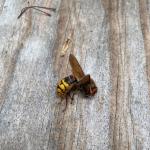
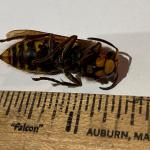 Wasps/Hornets: Many wasps are predators of other arthropods, including pest insects such as certain caterpillars that feed on trees and shrubs. Adult wasps hunt prey and bring it back to their nest where young are being reared, as food for the immature wasps. A common such example are the paper wasps (Polistes spp.) who rear their young on chewed up insects. They may be seen searching plants for caterpillars and other soft-bodied larvae to feed their young. Paper wasps can sting, and will defend their nests, which are open-celled paper nests that are not covered with a papery “envelope”. These open-celled nests may be seen hanging from eaves or other outdoor building structures. Aerial yellow jackets and hornets create large aerial nests that are covered with a papery shell or “envelope”. Common yellow jacket species include those in the genus Vespula. Dolichovespula maculata is commonly known as the baldfaced hornet, although it is not a true hornet. The European hornet (Vespa crabro) is three times the size of a yellow jacket and may be confused for the Asian giant hornet (Vespa mandarinia). The European hornet is known to Massachusetts, but the Asian giant hornet is not. If you are concerned that you have found or photographed an Asian giant hornet, please report it here: https://massnrc.org/pests/report.aspx. A helpful ID tool, although developed for Texas by the USDA, depicts common look-a-like species that we also have in MA that can be confused for the Asian giant hornet and is found here: https://agrilife.org/lubbock/files/2020/05/Asian_Giant_Hornet_Look-alikes_101_Xanthe_Shirley.pdf.
Wasps/Hornets: Many wasps are predators of other arthropods, including pest insects such as certain caterpillars that feed on trees and shrubs. Adult wasps hunt prey and bring it back to their nest where young are being reared, as food for the immature wasps. A common such example are the paper wasps (Polistes spp.) who rear their young on chewed up insects. They may be seen searching plants for caterpillars and other soft-bodied larvae to feed their young. Paper wasps can sting, and will defend their nests, which are open-celled paper nests that are not covered with a papery “envelope”. These open-celled nests may be seen hanging from eaves or other outdoor building structures. Aerial yellow jackets and hornets create large aerial nests that are covered with a papery shell or “envelope”. Common yellow jacket species include those in the genus Vespula. Dolichovespula maculata is commonly known as the baldfaced hornet, although it is not a true hornet. The European hornet (Vespa crabro) is three times the size of a yellow jacket and may be confused for the Asian giant hornet (Vespa mandarinia). The European hornet is known to Massachusetts, but the Asian giant hornet is not. If you are concerned that you have found or photographed an Asian giant hornet, please report it here: https://massnrc.org/pests/report.aspx. A helpful ID tool, although developed for Texas by the USDA, depicts common look-a-like species that we also have in MA that can be confused for the Asian giant hornet and is found here: https://agrilife.org/lubbock/files/2020/05/Asian_Giant_Hornet_Look-alikes_101_Xanthe_Shirley.pdf.
Paper wasps and aerial yellowjackets overwinter as fertilized females (queens) and a single female produces a new nest annually in the late spring. Nests are abandoned at the end of the season. Annually, queens start new nests, laying eggs, and rearing new wasps to assist in colony/nest development. Some people are allergic to stinging insects, so care should be taken around wasp/hornet nests. Unlike the European honeybee (Apis mellifera), wasps and hornets do not have barbed stingers, and therefore can sting repeatedly when defending their nests. It is best to avoid their nests, and if that cannot be done and assistance is needed to remove them, consult a professional.
Woody ornamental insect and non-insect arthropod pests to consider, a selected few:
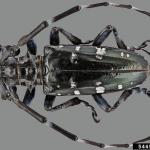
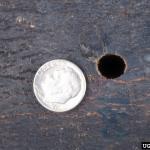
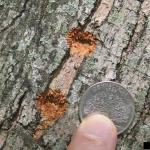 Asian Longhorned Beetle: (Anoplophora glabripennis, ALB) was recently detected for the first time in South Carolina. Asian longhorned beetle eradication programs currently exist in Massachusetts, New York, and Ohio. A homeowner is responsible for finding, reporting, and making officials aware of the infestation in South Carolina. Great job!
Asian Longhorned Beetle: (Anoplophora glabripennis, ALB) was recently detected for the first time in South Carolina. Asian longhorned beetle eradication programs currently exist in Massachusetts, New York, and Ohio. A homeowner is responsible for finding, reporting, and making officials aware of the infestation in South Carolina. Great job!
The U.S. Department of Agriculture’s (USDA) Animal and Plant Health Inspection Service (APHIS) and the Clemson University’s Department of Plant Industry (DPI) are inspecting trees in Hollywood, South Carolina following the detection and identification of the Asian longhorned beetle (ALB).
On May 29, a homeowner in Hollywood, South Carolina contacted DPI to report they found a dead beetle on their property and suspected it was ALB. A DPI employee collected the insect the same day and conducted a preliminary survey of the trees on the property. Clemson’s Plant and Pest Diagnostic Clinic provided an initial identification of ALB, and on June 4, APHIS’ National Identification Services confirmed the insect. On June 11, APHIS and DPI inspectors confirmed that one tree on the property is infested, and a second infested tree was found on an adjacent property. For more information, visit: https://www.aphis.usda.gov/aphis/newsroom/stakeholder-info/sa_by_date/sa-2020/sa-06/alb-sc
This is a perfectly timed reminder for us to remain vigilant, and report any suspicious beetles or damage to trees, especially maples. Asian longhorned beetle infests 12 genera of trees, however maples are preferred hosts.
Look for signs of an ALB infestation which include perfectly round exit holes (about the size of a dime), shallow oval or round scars in the bark where a female has chewed an egg site, or sawdust-like frass (excrement) on the ground nearby host trees or caught in between branches. Be advised that other, native insects may create perfectly round exit holes or sawdust-like frass, which can be confused with signs of ALB activity.
The regulated area for Asian longhorned beetle is 110 miles2 encompassing Worcester, Shrewsbury, Boylston, West Boylston, and parts of Holden and Auburn. If you believe you have seen damage caused by this insect, such as exit holes or egg sites, on susceptible host trees like maple, please call the Asian Longhorned Beetle Eradication Program office in Worcester, MA at 508-852-8090 or toll free at 1-866-702-9938.
To report an Asian longhorned beetle find online or compare it to common insect look-alikes, visit: http://massnrc.org/pests/albreport.aspx or https://www.aphis.usda.gov/pests-diseases/alb/report .
More information can be found in the “Trouble Maker of the Month” section of July’s edition of Hort Notes:https://ag.umass.edu/landscape/newsletters/hort-notes/hort-notes-2020-vol-315
- White Spotted Pine Sawyer (WSPS): Monochamus scutellatus adults can emerge in late May throughout July, depending on local temperatures. The Asian Longhorned Beetle Eradication Program reports that white spotted pine sawyer adult beetle activity has increased recently. This is a native insect in Massachusetts and is usually not a pest. Larvae develop in weakened or recently dead conifers, particularly eastern white pine (Pinus strobus). However, the white spotted pine sawyer looks very similar to the invasive Asian Longhorned Beetle, Anoplophora glabripennis, ALB. ALB adults do not emerge in Massachusetts until July and August. Beginning in July, look for the key difference between WSPS and ALB adults, which is a white spot in the top center of the wing covers (the scutellum) on the back of the beetle. White spotted pine sawyer will have this white spot, whereas Asian longhorned beetle will not. Both insects can have other white spots on the rest of their wing covers; however, the difference in the color of the scutellum is a key characteristic. See the Asian longhorned beetle entry above for more information about that non-native insect.
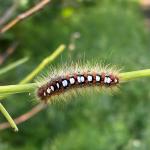
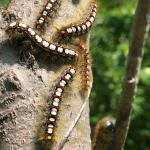
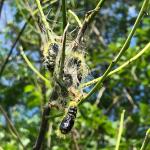
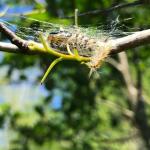
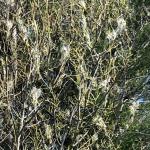
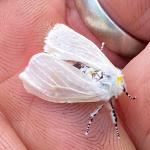
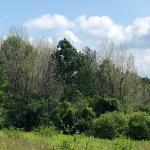
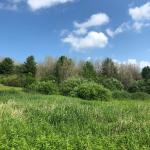 White Satin Moth: Leucoma salicis was recently reported from Beartown State Forest (Berkshire County) on 6/23/2020 by the Massachusetts Department of Conservation and Recreation, Forest Health Program. At this location, DCR estimates approximately 5-10 acres of defoliation due to the activity of this insect. Initial identification of the insect responsible for this activity was made by Marc DiGirolomo, a Forest Health Technician for the US Forest Service - Forest Health Protection (FHP) group in Durham, NH.The caterpillars of this species have a unique color pattern, which helps us distinguish them from others. The dorsal (back) side of the caterpillar is marked with 10-11 white, intersegmental spots as well as paired, red “setal warts”. The sides of the caterpillars are blueish gray. These caterpillars are known to the edges of waterways, woodlands, and forests from Canada to northwestern Connecticut and central New York. One generation occurs per year with mature caterpillars known in May and June. Host plants include aspen, poplar, and willow and are fed upon by the caterpillars of this species.
White Satin Moth: Leucoma salicis was recently reported from Beartown State Forest (Berkshire County) on 6/23/2020 by the Massachusetts Department of Conservation and Recreation, Forest Health Program. At this location, DCR estimates approximately 5-10 acres of defoliation due to the activity of this insect. Initial identification of the insect responsible for this activity was made by Marc DiGirolomo, a Forest Health Technician for the US Forest Service - Forest Health Protection (FHP) group in Durham, NH.The caterpillars of this species have a unique color pattern, which helps us distinguish them from others. The dorsal (back) side of the caterpillar is marked with 10-11 white, intersegmental spots as well as paired, red “setal warts”. The sides of the caterpillars are blueish gray. These caterpillars are known to the edges of waterways, woodlands, and forests from Canada to northwestern Connecticut and central New York. One generation occurs per year with mature caterpillars known in May and June. Host plants include aspen, poplar, and willow and are fed upon by the caterpillars of this species.
The white satin moth was introduced from Europe and first reported between Boston, MA and Hampton, New Hampshire in 1920. This insect is said to overwinter in the third instar (caterpillars pass through seven instars), either individually or in small groups. In the spring time, caterpillars leave their areas of hibernation to feed on nearby leaves. Caterpillars spin a thin cocoon between leaves or between exfoliating or thick bark crevices. Pupae are dark brown/black and often in a thin, loose silken sack. Pupae also sport brightly colored, yellow setae (hairs) that make them quite attractive. Pupation begins by the end of June. Shortly thereafter, moths emerge and females lay egg masses covered in a frothy, white material from July – mid-August. Eggs hatch sometime in August, and larvae will conduct feeding in August and September.
While caterpillars of this species are not noted to be of particular concern with regard to causing allergic reactions such as dermatitis, they are a type of tussock moth and do possess hairs, so they should either not be handled or approached with caution, particularly by sensitive individuals.
- Arborvitae Leafminer: In New England and eastern Canada, four species of leafminers are known to infest arborvitae. These include Argyresthia thuiella, A. freyella, A. aureoargentella, and Coleotechnites thujaella. The arborvitae leafminer, A. thuiella, is the most abundant of these and has the greatest known range when compared to the others. (It is also found in the Mid-Atlantic States and as far west as Missouri). Moths of this species appear from mid-June to mid-July and lay their eggs. The damage caused by all of these species is nearly identical. Trees, however, have been reported to lose up to 80% of their foliage due to arborvitae leafminer and still survive. At least 27 species of parasites have been reported as natural enemies of arborvitae leafminers, the most significant of which may be a parasitic wasp (Pentacnemus bucculatricis). Arborvitae leafminer damage causes the tips of shoots and foliage to turn yellow and brown. If infestations are light, prune out infested tips.
- Azalea Bark Scale: Eriococcus azaleae was discovered in CT in 1917 and has since been reported in other states. It is found on the bark of twigs and stems and commonly settles in branch crotches. It has been reported on azalea, rhododendron, andromeda, and others. Female scales are approximately 2-3 mm. in length and covered in a white, waxy coating. The females are purple in color and may resemble a mealybug, although they are a soft or felt scale. These females have overwintered and are going to lay eggs which will hatch into crawlers toward the end of June through mid-July. Crawlers will settle into branch crotches, bark crevices, or on the axils of leaves. There is a parasitic wasp that will attack these insects. When high in number, these scales can cause yellowing of the foliage and their sugary excrement can lead to the promotion of sooty mold. Because these are soft scales, they may be targeted with horticultural oils or insecticidal soaps while observing label instructions to prevent phytotoxicity.
- Azalea Sawflies: There are a few species of sawflies that impact azaleas. Johnson and Lyon's Insects that Feed on Trees and Shrubs mentions three of them. Amauronematus azaleae was first reported in New Hampshire in 1895 and is likely found in most of New England. Adults of this species are black with some white markings and wasp-like. Generally green larvae feed mostly on mollis hybrid azaleas. Remember, sawfly caterpillars have at least enough abdominal prolegs to spell “sawfly” (so 6 or more prolegs). Adults are present in May, and females lay their eggs and then larvae hatch and feed through the end of June. There is one generation per year. Nematus lipovskyi has been reared from swamp azalea (Rhododendron viscosum). Adults of that species have been collected in April (in states to the south) and May (in New England) and larval feeding is predominantly in late April and May in Virginia and June in New England. One generation of this species occurs per year, and most mollis hybrid azaleas can be impacted. A third species, Arge clavicornis, is found as an adult in July and lays its eggs in leaf edges in rows. Larvae are present in August and September. Remember, Bacillus thuringiensis Kurstaki does not manage sawflies.
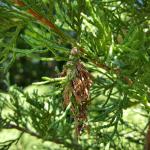 Bagworm: Thyridopteryx ephemeraeformis is a native species of moth whose larvae construct bag-like coverings over themselves with host plant leaves and twigs. This insect overwinters in the egg stage, within the bags of deceased females from last season. Eggs may hatch and young larvae are observed feeding around mid-June, or roughly between 600-900 GDD’s. Remove and destroy overwintering bags before June. In certain areas across MA in 2019, increased populations of bagworms were observed and reported. More information can be found here: https://ag.umass.edu/landscape/fact-sheets/bagworm
Bagworm: Thyridopteryx ephemeraeformis is a native species of moth whose larvae construct bag-like coverings over themselves with host plant leaves and twigs. This insect overwinters in the egg stage, within the bags of deceased females from last season. Eggs may hatch and young larvae are observed feeding around mid-June, or roughly between 600-900 GDD’s. Remove and destroy overwintering bags before June. In certain areas across MA in 2019, increased populations of bagworms were observed and reported. More information can be found here: https://ag.umass.edu/landscape/fact-sheets/bagworm- Cottony Taxus Scale: Pulvinaria floccifera, also referred to as the cottony camellia scale, utilizes such hosts as taxus, camellia, holly, hydrangea, Japanese maple, euonymus, magnolia, and jasmine, among others. Females have laid the long, narrow, white and fluted egg sac that makes them much more noticeable. Eggs will hatch over an extended period of 6 weeks and crawlers may be treated between 802-1388 GDD’s. This insect can cause the host to appear off-color. They also produce honeydew which promotes sooty mold growth. Dieback is not common with this insect. Target the underside of the foliage. Horticultural oil, neem oil, and insecticidal soaps may be used to manage these soft scales. Reduced risk options help preserve natural enemies.
- Dogwood Borer: Synanthedon scitula is a species of clearwing moth whose larvae bore not only into dogwood (Cornus), but hosts also include flowering cherry, chestnut, apple, mountain ash, hickory, pecan, willow, birch, bayberry, oak, hazel, myrtle, and others. Kousa dogwood appear to be resistant to this species. Signs include the sloughing of loose bark, brown frass, particularly near bark cracks and wounds, dead branches, and adventitious growth. The timing of adult emergence can be expected when dogwood flower petals are dropping and weigela begins to bloom. Adult moth flights continue from then until September. Emergence in some hosts (ex. apple) appears to be delayed, but this differs depending upon the location in this insect’s range. Eggs are laid singly, or in small groups, on smooth and rough bark. Female moths preferentially lay eggs near wounded bark. After hatch, larvae wander until they find a suitable entrance point into the bark. This includes wounds, scars, or branch crotches. This insect may also be found in twig galls caused by other insects or fungi. Larvae feed on phloem and cambium. Fully grown larvae are white with a light brown head and approx. ½ inch long. Pheromone traps and lures are useful for determining the timing of adult moth emergence and subsequent management.
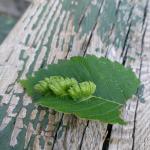 Elm Cockscomb Gall: This non-native aphid Colopha ulmicola, aka the elm cockscomb aphid, produces the odd leaf structures known as the elm cockscomb gall. The galls are green and worm-like when they are first formed, but as they mature they look more and more like chicken cockscombs and eventually even turn red in color. These will rise from elm leaves and although they may be unsightly to some, like with many leaf galls the damage they cause is purely aesthetic and typically does not warrant management.
Elm Cockscomb Gall: This non-native aphid Colopha ulmicola, aka the elm cockscomb aphid, produces the odd leaf structures known as the elm cockscomb gall. The galls are green and worm-like when they are first formed, but as they mature they look more and more like chicken cockscombs and eventually even turn red in color. These will rise from elm leaves and although they may be unsightly to some, like with many leaf galls the damage they cause is purely aesthetic and typically does not warrant management.- Emerald Ash Borer: (Agrilus planipennis, EAB) As of March 2020, the Massachusetts Department of Conservation and Recreation has confirmed a total of at least 116 communities in Massachusetts that have known populations of emerald ash borer. A map of these locations across the state may be found here: https://ag.umass.edu/fact-sheets/emerald-ash-borer .
This wood-boring beetle readily attacks ash (Fraxinus spp.) including white, green, and black ash and has also been found developing in white fringe tree (Chionanthus virginicus) and has been reported in cultivated olive (Olea europaea). Adult insects of this species will not be present at this time of year. Signs of an EAB infested tree may include (at this time) D-shaped exit holes in the bark (from adult emergence in previous years), “blonding” or lighter coloration of the ash bark from woodpecker feeding (chipping away of the bark as they search for larvae beneath), and serpentine galleries visible through splits in the bark, from larval feeding beneath. Positive identification of an EAB-infested tree may not be possible with these signs individually on their own.
For further information about this insect, please visit:https://ag.umass.edu/landscape/fact-sheets/emerald-ash-borer If you believe you have located EAB-infested ash trees, particularly in an area of Massachusetts not identified on the map provided, please report here: http://massnrc.org/pests/pestreports.htm .
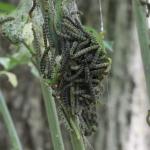 Euonymus Caterpillar: Yponomeuta cagnagella is of European origin and widespread in distribution throughout Europe. It was first reported in North America in Ontario in 1967. The euonymus caterpillars (larvae) feed in groups and envelop the foliage of the host plant in webs as they feed. Hosts include: Euonymus europaeus (tree form), E. kiautschovicus, E. alatus, and E. japonicus. Mature caterpillars are just under an inch in length, creamy yellow-gray in color with black spots and a black head capsule. By late June, these larvae pupate in white, oval-shaped cocoons which are typically oriented together vertically either on host plants or non-hosts in the area. Cocoons can be found in cracks and crevices, or webbed together leaves. The adult moth emerges in late June in most locations. The adult female secretes a gummy substance over her eggs which will harden, making them even more difficult to see. Eggs hatch by mid-August, at which time the tiny larvae prepare to overwinter beneath their eggshell-like covering. These larvae are inactive until the following year, when caterpillars group together to feed on newly emerging leaves, creating a mess of webs as they feed. There is one generation per year. Plants may be partially or entirely defoliated. Management of young, actively feeding caterpillars with Bacillus thuringiensis is possible if deemed necessary, however many species of Euonymus are considered invasive themselves.
Euonymus Caterpillar: Yponomeuta cagnagella is of European origin and widespread in distribution throughout Europe. It was first reported in North America in Ontario in 1967. The euonymus caterpillars (larvae) feed in groups and envelop the foliage of the host plant in webs as they feed. Hosts include: Euonymus europaeus (tree form), E. kiautschovicus, E. alatus, and E. japonicus. Mature caterpillars are just under an inch in length, creamy yellow-gray in color with black spots and a black head capsule. By late June, these larvae pupate in white, oval-shaped cocoons which are typically oriented together vertically either on host plants or non-hosts in the area. Cocoons can be found in cracks and crevices, or webbed together leaves. The adult moth emerges in late June in most locations. The adult female secretes a gummy substance over her eggs which will harden, making them even more difficult to see. Eggs hatch by mid-August, at which time the tiny larvae prepare to overwinter beneath their eggshell-like covering. These larvae are inactive until the following year, when caterpillars group together to feed on newly emerging leaves, creating a mess of webs as they feed. There is one generation per year. Plants may be partially or entirely defoliated. Management of young, actively feeding caterpillars with Bacillus thuringiensis is possible if deemed necessary, however many species of Euonymus are considered invasive themselves.
Want to see euonymus caterpillars in action?! I bet you’ve never seen so many of these caterpillars in one place! Check out Episode 3 of InsectXaminer: https://ag.umass.edu/landscape/education-events/insectxaminer
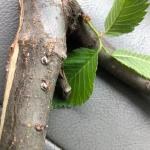 European Elm Scale: Gossyparia spuria is a type of felt scale and was reported to UMass Extension as active in Quincy, MA on 6/3/20. First noted in New York in 1884, this non-native scale is now widespread in North America and is found on native and European elms, but also rarely on hackberry and Zelkova. This insect can cause yellowing of foliage, premature leaf drop, and eventually dieback on its host. Honeydew and thus sooty mold are produced. The females observed in Quincy, MA have produced a ring of white fibers around their black, oval bodies. By the end of June, these females will lay eggs that hatch into bright yellow crawlers, which will disperse to the midrib and leaf veins on the underside of elm leaves where they will remain to feed. Crawlers are tiny and magnification is necessary to observe. Natural enemies such as parasitic wasps and predatory insects have been reported as successful in managing this insect.
European Elm Scale: Gossyparia spuria is a type of felt scale and was reported to UMass Extension as active in Quincy, MA on 6/3/20. First noted in New York in 1884, this non-native scale is now widespread in North America and is found on native and European elms, but also rarely on hackberry and Zelkova. This insect can cause yellowing of foliage, premature leaf drop, and eventually dieback on its host. Honeydew and thus sooty mold are produced. The females observed in Quincy, MA have produced a ring of white fibers around their black, oval bodies. By the end of June, these females will lay eggs that hatch into bright yellow crawlers, which will disperse to the midrib and leaf veins on the underside of elm leaves where they will remain to feed. Crawlers are tiny and magnification is necessary to observe. Natural enemies such as parasitic wasps and predatory insects have been reported as successful in managing this insect.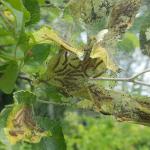
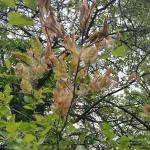 Fall Webworm: Hyphantria cunea is native to North America and Mexico. It is now considered a world-wide pest, as it has spread throughout much of Europe and Asia. (For example, it was introduced accidentally into Hungary from North America in the 1940’s.) Hosts include nearly all shade, fruit, and ornamental trees except conifers. In the USA, at least 88 species of trees are hosts for these insects, while in Europe at least 230 species are impacted. In the past history of this pest, it was once thought that the fall webworm was a two-species complex. It is now thought that H. cunea has two color morphs – one black headed and one red headed. These two color forms differ not only in the coloration of the caterpillars and the adults, but also in their behaviors. Caterpillars may go through at least 11 molts, each stage occurring within a silken web they produce over the host. When alarmed, all caterpillars in the group will move in unison in jerking motions that may be a mechanism for self-defense. Depending upon the location and climate, 1-4 generations of fall webworm can occur per year. Fall webworm adult moths lay eggs on the underside of the leaves of host plants in the spring. These eggs hatch in late June or early July depending on climate. Fall webworm caterpillars were observed feeding on foliage coated in webbing on 7/8/2020 in Chesterfield, MA. Young larvae feed together in groups on the undersides of leaves, first skeletonizing the leaf and then enveloping other leaves and eventually entire branches within their webs. Webs are typically found on the terminal ends of branches. All caterpillar activity occurs within this tent, which becomes filled with leaf fragments, cast skins, and frass. Fully grown larvae then wander from the webs and pupate in protected areas such as the leaf litter where they will remain for the winter. Adult fall webworm moths emerge the following spring/early summer to start the cycle over again. 50+ species of parasites and 36+ species of predators are known to attack fall webworm in North America. Fall webworms typically do not cause extensive damage to their hosts. Nests may be an aesthetic issue for some. If in reach, small fall webworm webs may be pruned out of trees and shrubs and destroyed. Do not set fire to H. cunea webs when they are still attached to the host plant.
Fall Webworm: Hyphantria cunea is native to North America and Mexico. It is now considered a world-wide pest, as it has spread throughout much of Europe and Asia. (For example, it was introduced accidentally into Hungary from North America in the 1940’s.) Hosts include nearly all shade, fruit, and ornamental trees except conifers. In the USA, at least 88 species of trees are hosts for these insects, while in Europe at least 230 species are impacted. In the past history of this pest, it was once thought that the fall webworm was a two-species complex. It is now thought that H. cunea has two color morphs – one black headed and one red headed. These two color forms differ not only in the coloration of the caterpillars and the adults, but also in their behaviors. Caterpillars may go through at least 11 molts, each stage occurring within a silken web they produce over the host. When alarmed, all caterpillars in the group will move in unison in jerking motions that may be a mechanism for self-defense. Depending upon the location and climate, 1-4 generations of fall webworm can occur per year. Fall webworm adult moths lay eggs on the underside of the leaves of host plants in the spring. These eggs hatch in late June or early July depending on climate. Fall webworm caterpillars were observed feeding on foliage coated in webbing on 7/8/2020 in Chesterfield, MA. Young larvae feed together in groups on the undersides of leaves, first skeletonizing the leaf and then enveloping other leaves and eventually entire branches within their webs. Webs are typically found on the terminal ends of branches. All caterpillar activity occurs within this tent, which becomes filled with leaf fragments, cast skins, and frass. Fully grown larvae then wander from the webs and pupate in protected areas such as the leaf litter where they will remain for the winter. Adult fall webworm moths emerge the following spring/early summer to start the cycle over again. 50+ species of parasites and 36+ species of predators are known to attack fall webworm in North America. Fall webworms typically do not cause extensive damage to their hosts. Nests may be an aesthetic issue for some. If in reach, small fall webworm webs may be pruned out of trees and shrubs and destroyed. Do not set fire to H. cunea webs when they are still attached to the host plant.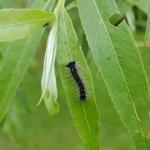 Gypsy Moth:(Lymantria dispar) thanks to the gypsy moth caterpillar killing fungus, Entomophaga maimaiga, the recent outbreak of gypsy moth in Massachusetts has come to an end! Most locations in Massachusetts will not see damaging or even noticeable populations of this insect in 2020.
Gypsy Moth:(Lymantria dispar) thanks to the gypsy moth caterpillar killing fungus, Entomophaga maimaiga, the recent outbreak of gypsy moth in Massachusetts has come to an end! Most locations in Massachusetts will not see damaging or even noticeable populations of this insect in 2020.
Gypsy moth has been in Massachusetts since the 1860's. This invasive insect from Europe often goes unnoticed, thanks to population regulation provided by the entomopathogenic fungus, E. maimaiga, as well as a NPV virus specific to gypsy moth caterpillars. (And to a lesser extent many other organisms, including other insects, small mammals, and birds who feed on gypsy moth.) However, if environmental conditions do not favor the life cycle of the fungus, outbreaks of gypsy moth caterpillars are possible. (Such as most recently from 2015-2018, with a peak in the gypsy moth population in 2017 in Massachusetts.)
Missing gypsy moth already? Check out Episode 1 of InsectXaminer to reminisce about the 2015-2018 outbreak of this insect: https://ag.umass.edu/landscape/education-events/insectxaminer
- Hemlock Looper: Two species of geometrid moths in the genus Lambdina are native insects capable of defoliating eastern hemlock, balsam fir, and white spruce. Adult moths lay their eggs on the trunk and limbs of hosts in September and October, and eggs will hatch by late May or early June. (L. fiscellaria caterpillars may be active between 448-707 GDD’s.) Monitor susceptible hosts for small, inch-worm like caterpillars. Where populations are low, no management is necessary. Hemlock loopers have several effective
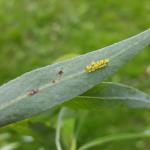
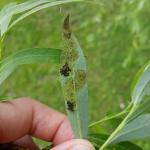 Imported Willow Leaf Beetle: Plagiodera versicolora adult beetles overwinter near susceptible hosts. Adult beetles will chew holes and notches in the leaves of willow once they become available. Imported willow leaf beetle adults were observed feeding and mating in Chesterfield, MA on 5/20/2020. Adults continued to feed and mate on 5/26/2020 and egg laying has been observed. Females lay yellow eggs in clusters on the undersides of leaves. While clusters of yellow eggs could still be found, tiny larvae hatched and were beginning to skeletonize willow leaves, as observed on 6/3/20 in Chesterfield, MA. By 6/7/20, imported willow leave beetle larvae had grown larger and were skeletonizing willow leaves in Chesterfield, MA. Larvae are slug-like and bluish-green in color. They will feed in clusters and skeletonize the leaves. Most plants can tolerate the feeding from this insect, and foliage will appear brown. Repeated yearly feeding can be an issue, in which case management of the young larvae may be necessary. Take care with treatment in areas near water. Imported willow leaf beetle may have 2 generations per year in New England (4 generations per year are possible in the warmer locations of its introduced range).
Imported Willow Leaf Beetle: Plagiodera versicolora adult beetles overwinter near susceptible hosts. Adult beetles will chew holes and notches in the leaves of willow once they become available. Imported willow leaf beetle adults were observed feeding and mating in Chesterfield, MA on 5/20/2020. Adults continued to feed and mate on 5/26/2020 and egg laying has been observed. Females lay yellow eggs in clusters on the undersides of leaves. While clusters of yellow eggs could still be found, tiny larvae hatched and were beginning to skeletonize willow leaves, as observed on 6/3/20 in Chesterfield, MA. By 6/7/20, imported willow leave beetle larvae had grown larger and were skeletonizing willow leaves in Chesterfield, MA. Larvae are slug-like and bluish-green in color. They will feed in clusters and skeletonize the leaves. Most plants can tolerate the feeding from this insect, and foliage will appear brown. Repeated yearly feeding can be an issue, in which case management of the young larvae may be necessary. Take care with treatment in areas near water. Imported willow leaf beetle may have 2 generations per year in New England (4 generations per year are possible in the warmer locations of its introduced range).
Want to see the imported willow leaf beetle in action? Check out the NEW short (2 min 53 sec) InsectXaminer video now available here:https://ag.umass.edu/landscape/education-events/insectxaminer
- Lacebugs: Stephanitis spp. lacebugs such as S. pyriodes can cause severe injury to azalea foliage. S. rhododendri can be common on rhododendron and mountain laurel. S. takeyai has been found developing on Japanese andromeda, leucothoe, styrax, and willow. Stephanitis spp. lace bug activity should be monitored through September. Before populations become too large, treat with a summer rate horticultural oil spray as needed. Be sure to target the undersides of the foliage in order to get proper coverage of the insects. Certain azalea and andromeda cultivars may be less preferred by lace bugs.
- Lecanium Scales (Oak): Parthenolecanium quercifex overwinters as a second instar nymph on oak twigs. Females will begin feeding and mature in the spring, from mid-April to early May and eggs may be laid between late May and into June. Eggs hatch in June or early July and crawlers migrate to host plant leaves where they spend the summer and migrate as second instars back to host plant twigs in the fall. Mid-April to early-May (35-145 GDD’s) for dormant oil applications.
- Lilac Borer: Podosesia syringae is a clearwing moth pest of lilac, privet, fringetree, and ash. (It is also known as the ash borer, not to be confused with the emerald ash borer.) Adults mimic paper wasps. Larvae are wood-boring, and signs and symptoms include branch dieback, holes, and occasionally, sawdust-like frass accumulated on bark. Larvae bore into stems, trunks, and branches, chewing an irregularly shaped entrance hole. Peak adult moth flights may occur in the northern portion of this insect’s range in June and is usually over by August 1st. Pheromone traps can be used to time adult emergence. Adult females lay flattened, oval, and tan eggs that are deposited singly or in clusters on bark crevices, ridges, and sometimes smooth bark; but usually laid in or near wounds in the bark. On average, 395 eggs are laid by each female. After hatch, larvae chew into the bark and feed laterally and then vertically in phloem tissue. Larvae overwinter in tunnels in the final instar and resume feeding in the spring. Adults emerge through a round exit hole (4-5 mm. in diameter). This insectmay be targeted between 200-299 GDD’s, base 50°F.
- Magnolia Scale: Neolecanium cornuparvum overwinters as first instar nymphs which are elliptical, and dark slate gray in color and can usually be found on the undersides of 1 and 2 year old twigs. Nymphs may molt by late April or May and again by early June at which time the scales may be purple in color. Eventually nymphs secrete a white powdery layer of wax over their bodies.
- Rhododendron Borer: Synanthedon rhododendri is one of the smallest of the native clearwing moths. Rhododendrons are preferred hosts, although mountain laurel, and deciduous azaleas can be heavily infested, especially if they are planted in close proximity to rhododendrons. Injury may be first noticed in the fall (leaves lose their sheen, then become pale green, then olive, then chlorotic) and can look similar to drought stress. On branches that seem to be stunted, look at limb crotches, scars, and other irregularities for sawdust stuck on bark or on the ground beneath these areas. In late May and early June, holes may contain pupal shed skins extending halfway out. Moth emergence occurs in the late-spring, early-summer. After mating, female moths seek out suitable egg laying locations (preferring wounded areas or limb crotches). The female lays her eggs and dies. Eggs hatch and larvae tunnel into the inner bark where they feed in tunnels that become packed with reddish frass pellets. By late fall, larvae move to the sapwood where they overwinter and resume feeding by mid-March. Pupation occurs in the spring and there is one generation per year. Prune out and destroy infested branches before late May/June. Monitor for adults in mid-May (192-298 GDD’s, base 50°F).
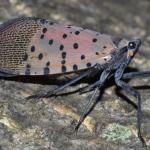 Spotted Lanternfly: (Lycorma delicatula, SLF) is not known to occur in Massachusetts landscapes (no established populations are known in MA at this time). However, due to the great ability of this insect to hitchhike using human-aided movement, it is important that we remain vigilant in Massachusetts and report any suspicious findings. Spotted lanternfly reports can be sent here:https://massnrc.org/pests/slfreport.aspx
Spotted Lanternfly: (Lycorma delicatula, SLF) is not known to occur in Massachusetts landscapes (no established populations are known in MA at this time). However, due to the great ability of this insect to hitchhike using human-aided movement, it is important that we remain vigilant in Massachusetts and report any suspicious findings. Spotted lanternfly reports can be sent here:https://massnrc.org/pests/slfreport.aspx
For a map of known, established populations of SLF as well as detections outside of these areas where individual finds of spotted lanternfly have occurred (but no infestations are present), visit: https://nysipm.cornell.edu/environment/invasive-species-exotic-pests/spotted-lanternfly/ This map depicts an individual find of spotted lanternfly at a private residence in Boston, MA that was reported by the MA Department of Agricultural Resources on February 21, 2019. More information about this detection in Boston, where no established infestation was found, is provided here: https://www.mass.gov/news/state-agricultural-officials-urge-residents-to-check-plants-for-spotted-lanternfly
This insect is a member of the Order Hemiptera (true bugs, cicadas, hoppers, aphids, and others) and the Family Fulgoridae, also known as planthoppers. The spotted lanternfly is a non-native species first detected in the United States in Berks County, Pennsylvania and confirmed on September 22, 2014.
The spotted lanternfly is considered native to China, India, and Vietnam. It has been introduced as a non-native insect to South Korea and Japan, prior to its detection in the United States. In South Korea, it is considered invasive and a pest of grapes and peaches. The spotted lanternfly has been reported from over 70 species of plants, including the following: tree of heaven (Ailanthus altissima) (preferred host), apple (Malus spp.), plum, cherry, peach, apricot (Prunus spp.), grape (Vitis spp.), pine (Pinus spp.), pignut hickory (Carya glabra), sassafras (Sassafras albidum), serviceberry (Amelanchier spp.), slippery elm (Ulmus rubra), tulip poplar (Liriodendron tulipifera), white ash (Fraxinus americana), willow (Salix spp.), American beech (Fagus grandifolia), American linden (Tilia americana), American sycamore (Platanus occidentalis), big-toothed aspen (Populus grandidentata), black birch (Betula lenta), black cherry (Prunus serotina), black gum (Nyssa sylvatica), black walnut (Juglans nigra), dogwood (Cornus spp.), Japanese snowbell (Styrax japonicus), maple (Acer spp.), oak (Quercus spp.), and paper birch (Betula papyrifera).
The adults and immatures of this species damage host plants by feeding on sap from stems, leaves, and the trunks of trees. In the springtime in Pennsylvania (late April - mid-May) nymphs (immatures) are found on smaller plants and vines and new growth of trees and shrubs. Third and fourth instar nymphs migrate to the tree of heaven and are observed feeding on trunks and branches. Trees may be found with sap weeping from the wounds caused by the insect’s feeding. The sugary secretions (excrement) created by this insect may coat the host plant, later leading to the growth of sooty mold. Insects such as wasps, hornets, bees, and ants may also be attracted to the sugary waste created by the lanternflies, or sap weeping from open wounds in the host plant. Host plants have been described as giving off a fermented odor when this insect is present.
Adults are present by the middle of July in Pennsylvania and begin laying eggs by late September and continue laying eggs through late November and even early December in that state. Adults may be found on the trunks of trees such as the tree of heaven or other host plants growing in close proximity to them. Egg masses of this insect are gray in color and look similar in some ways to gypsy moth egg masses.
Host plants, bricks, stone, lawn furniture, recreational vehicles, and other smooth surfaces can be inspected for egg masses. Egg masses laid on outdoor residential items such as those listed above may pose the greatest threat for spreading this insect via human aided movement.
For more information about the spotted lanternfly, visit this fact sheet: https://ag.umass.edu/landscape/fact-sheets/spotted-lanternfly .
- Taxus Mealybug: Dysmicoccus wistariae will produce honeydew and lead to sooty mold growth, yellowing of needles, and sparsely foliated plants. Eventual dieback may be possible. This species is commonly associated with taxus in New England, but can be occasionally found on dogwood, rhododendron, Prunus spp., maple, andromeda, and crabapple. These mealybugs are found on stems and branches and particularly like to congregate at branch crotches. Taxus mealybug feeds in the inner bark tissue of the trunk and branches. Adult females are present from June to August and give birth to living young in the summer. Immatures overwinter. A single generation may occur per year in New England, but areas to the south can have multiple generations of this insect. Management may be targeted between 246-618 GDD’s, base 50°F. Horticultural oil and neem oil may be used.
- Twolined Chestnut Borer: Agrilus bilineatus is a native jewel beetle (also known as a flatheaded borer) in the Family Buprestidae. This insect is also in the same genus as the invasive emerald ash borer. The twolined chestnut borer is native to Massachusetts, much of New England, and the eastern United States. This species has one generation per year and adults are typically active from April – August, depending upon location and temperature. Adults will conduct some maturation feeding on oak prior to mating. Females will lay clusters of tiny eggs in the cracks and crevices of bark. Larvae hatch from the eggs in 1-2 weeks and burrow through the bark into the cambium, where they feed in a similar manner to the emerald ash borer, creating meandering galleries as they feed. (The galleries of the twolined chestnut borer can be straight in very stressed trees.) Larvae typically mature by August – October and burrow to the outer bark where they create a chamber in which they overwinter. Pupation occurs the following spring and adults emerge through D-shaped exit holes that are approximately 1/5 inch wide. In the northern extent of this insect’s range, they can take 2 years to complete their life cycle. Larvae of this insect have been recorded from eastern white oak, common post oak, burr oak, scarlet oak, northern red oak, and eastern black oak. Adults have been recorded on fir and pin oak. These insects are attracted to stressed host plants and typically become a secondary factor in the decline of the tree.
Concerned that you may have found an invasive insect or suspicious damage caused by one? Need to report a pest sighting? If so, please visit the Massachusetts Introduced Pests Outreach Project: http://massnrc.org/pests/pestreports.htm .
A note about Tick Awareness: deer ticks (Ixodes scapularis), the American dog tick (Dermacentor variabilis), and the lone star tick (Amblyomma americanum) are all found throughout Massachusetts. Each can carry their own complement of diseases. Anyone working in tick habitats (wood-line areas, forested areas, and landscaped areas with ground cover) should check themselves regularly for ticks while practicing preventative measures. Have a tick and need it tested? Visit the web page of the UMass Laboratory of Medical Zoology (https://www.tickreport.com/ ) and click on the blue Order a TickReport button for more information.
Reported by Tawny Simisky, Extension Entomologist, UMass Extension Landscape, Nursery, & Urban Forestry Program
Weeds
Summer annual grass and broadleaf weeds are becoming increasingly more apparent in mulched landscape beds. Most summer annuals have germinated by now and the recent hot weather has allowed them to get VERY large. Some weeds have become sizable and spraying them will result in unsightly dead vegetation, so hand weeding may be necessary. However, spot spraying with a non-selective herbicide is usually a better strategy than hand-weeding because it does not break the mulch barrier unless the plant is clipped below the stem base, allowing new weed seeds to germinate. Determination on a site-by-site basis will be needed to select the best strategy. Inspect the mulch layer to ensure that it is thick enough to control future weed problems.
Many landscape trees commonly produce vegetative suckers at their trunk base. Suckers are commonly seen on crabapple, flowering cherry, flowering pear, plum, linden, maple and sometimes oak. Honeylocusts commonly produces vegetative sprouts along the entire length of their trunk. If these suckers or sprouts are not controlled, the landscape will be a contender for the “shabby landscape award”. Pruning is effective but very time consuming. Another option would be to use the product ScytheTM that contains pelargonic acid to remove these vegetative suckers and sprouts when they are very small. Very small means less than one inch in length or smaller. Pelargonic acid is a contact herbicide. If ScytheTM is applied to small suckers and sprouts, the product will desiccate them and physical removal will not be required. Larger growth will first need to be physically removed, then ScytheTM can be used as a maintenance program. Products that contain glyphosate should not be used as glyphosate is a translocated herbicide and injury is possible.
Do not delay, treat garlic mustard, Alliaria petiolata, now. Plants have matured to a point where seedpods have formed and the seeds are now mature. Plants with mature seedpods will need to be physically removed from the site. First year plants can still be treated with an herbicide.
New growth expansion of poison ivy continues. Poison ivy is past its flowering period and small green berries can be seen on healthy plants. Herbicide applications can be done from now through mid-September. Glyphosate or triclopyr are the best herbicides for the control of poison ivy. Site will determine which herbicide you select. Glyphosate is a non-selective herbicide, while triclopyr is a broadleaf herbicide, so it will not kill grasses.
Report by Randy Prostak, Weed Specialist, UMass Extension Landscape, Nursery and Urban Forestry Program
Landscape Practices
With two-thirds of Massachusetts in a "Moderate Drought" or "Abnormally Dry" as of 7/7 , according to the US Drought Monitor (https://droughtmonitor.unl.edu/CurrentMap/StateDroughtMonitor.aspx?MA), it is important to irrigate as efficiently as possible. The following tips will help ensure that irrigation applications are as beneficial as possible.
1. Be aware of, and follow, your local town or municipality water regulations.
2. Don’t irrigate midday. Evaporation is greatest midday, which could mean that much of the water being applied is lost before it reaches plants! Wind also contributes to evaporation and can change irrigation spray patterns. Early morning and evening are the best times to irrigate.
3. Use drip irrigation or soaker hoses when possible. Overhead irrigation frequently results in watering non-plant surfaces and can result in water interception by plant canopies which can reduce the water that reaches the plants’ root systems.
4. Maintain your irrigation system. Check for leaks, broken spray heads, and perform an irrigation system audit to assure uniformity.
5. Use smart technology. Smart controllers can monitor soil moisture and use environmental conditions to adjust irrigation based on water being lost to evapotranspiration (evaporation and transpiration).
6. Water deeply, allowing water to soak into the ground. Irrigating slowly (via drip irrigation or a slow flow) is key to achieving infiltration vs. runoff. Newly installed plants will need more frequent irrigation until established, especially container grown plants that were produced in soilless substrates. Less frequent, deeper irrigation encourages good root growth which will help plants survive water stress.
7. Apply mulch to planting beds and in tree rings 2-4” deep. Keep mulch away from the base of plants and trees. Mulch helps reduce evaporation, insulates plant roots, and can add organic matter to the soil.
8. Raise your mower blade. Longer grass promotes deeper roots and a more drought-resistant lawn.
9. Reduce the competition for water by controlling weeds.
10. Don’t apply fertilizer under drought conditions. High fertilizer concentration can make available water unavailable to plants. Fertilization will also result in increased growth which increases the water demand.
11. Keep in mind that landscapes typically require one inch of water per week (including rainfall). Unsure of what your system or sprinkler is applying? You can use a rain gauge and see how much water is collected in a certain period of time (30 minutes for example). Use multiple rain gauges if possible to understand if you have good uniformity, or make sure the rain gauge is located in an “average area”.
Report by Mandy Bayer, Extension Assistant Professor of Sustainable Landscape Horticulture, UMass Stockbridge School of Agriculture
Landscape Turf
Insects
White Grubs
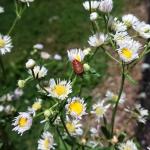
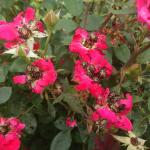 Adults of Oriental and Asiatic garden beetles are at the peak of their flight, and Japanese beetle adult activity is increasing. Adult Oriental and Asiatic garden beetles are flying at night (~8:30 -10:00 PM) and are attracted to light (Oriental beetles also sometimes fly during the day). Japanese beetle adults are active during the day and can be observed on many ornamental plants. Adult flight is a good indication for scheduling neonicotinoid preventive applications, targeting young larvae that will be hatching from eggs. Ideally all applications should be completed by the end of July. It is too late to apply chlorantraniliprole (AceleprynTM) for grubs. The window of opportunity for chlorantraniliprole was earlier, until June 15. Another diamide, cyantraniliprole (FerenceTM) can be applied at the same time as neonicotinoids.
Adults of Oriental and Asiatic garden beetles are at the peak of their flight, and Japanese beetle adult activity is increasing. Adult Oriental and Asiatic garden beetles are flying at night (~8:30 -10:00 PM) and are attracted to light (Oriental beetles also sometimes fly during the day). Japanese beetle adults are active during the day and can be observed on many ornamental plants. Adult flight is a good indication for scheduling neonicotinoid preventive applications, targeting young larvae that will be hatching from eggs. Ideally all applications should be completed by the end of July. It is too late to apply chlorantraniliprole (AceleprynTM) for grubs. The window of opportunity for chlorantraniliprole was earlier, until June 15. Another diamide, cyantraniliprole (FerenceTM) can be applied at the same time as neonicotinoids.
Please note: Neonicotinoids can be toxic to pollinators including honeybees and wild bees. Cyantraniliprole is highly toxic to bees, even though it belongs to the same chemical class (anthranilic diamides) as chlorantaniliprole, which has low bee toxicity. Several measures could be taken to reduce exposure of foraging bees to insecticides: (1) avoiding application on flowering plants, (2) mowing before the application to reduce flowers which attract pollinators, (2) watering in products after application, (3) using granular formulations, (4) avoiding spraying during high winds to minimize drift, (5) and considering spraying in the evening or early in the morning when bees are not foraging. For more information on this topic, see our Neonicotinoid Turf Insecticides and Pollinators fact sheet. https://ag.umass.edu/turf/fact-sheets/neonicotinoid-turf-insecticides-pollinators
It is important to know which white grub species are present and active at your location. For most locations in southern New England, Oriental beetle grubs are the most dominant. However, species composition varies and can be affected by the specific location and the surrounding landscapes. If you noticed many Asiatic garden beetle (AGB) adults flying in your area, neonicotinoid application will most likely not to be effective against this species. Fortunately, AGB is smaller than other grub species and turf can tolerate higher densities (up to 20 per sq. ft.). In addition, AGB frequently occurs in lower maintenance turf, so they rarely cause damage requiring curative application. Monitoring turf quality and grub abundance will determine the need for the curative applications.
Billbugs
It is time to watch for billbug damage. If you notice damage in an area with known or suspected billbug infestation, perform a “tug” test: pull the damaged grass, if it easily breaks off and you see uneven/chewed up ends with sawdust-like larval frass, billbugs are possible culprits. Ideally, soil samples should also be taken and examined for larval activity. Most of the larvae can be found in the thatch zone. Remember that billbug damage often resembles summer dormancy, so lawns that have been struggling in the recent high temperatures and dry conditions may appear to be dormant, but in fact there may be billbug larvae feeding in the area. If that is the case, the turf may not recover when cooler temperatures prevail in September.
Submitted by: Dr. Olga Kostromytska and Dr. Pat Vittum
Additional Resources
To receive immediate notification when the next Landscape Message update is posted, join our email list by emailing your request to eweeks@umext.umass.edu with Subscribe Greeninfo in the subject line, and follow us on Facebook and Twitter.
For a complete listing of upcoming events, see our upcoming educational events https://ag.umass.edu/landscape/upcoming-events
For commercial growers of greenhouse crops and flowers - Check out UMass Extension's Greenhouse Update website
For professional turf managers - Check out Turf Management Updates
For home gardeners and garden retailers - Check out our home lawn and garden resources. UMass Extension also has a Twitter feed that provides timely, daily gardening tips, sunrise and sunset times to home gardeners at twitter.com/UMassGardenClip
Diagnostic Services
A UMass Laboratory Diagnoses Landscape and Turf Problems - The UMass Extension Plant Diagnostic Lab is available to serve commercial landscape contractors, turf managers, arborists, nurseries and other green industry professionals. It provides woody plant and turf disease analysis, woody plant and turf insect identification, turfgrass identification, weed identification, and offers a report of pest management strategies that are research based, economically sound and environmentally appropriate for the situation. Accurate diagnosis for a turf or landscape problem can often eliminate or reduce the need for pesticide use. For sampling procedures, detailed submission instructions and a list of fees, see Plant Diagnostics Laboratory
Soil and Plant Nutrient Testing - The University of Massachusetts Soil and Plant Nutrient Testing Laboratory is located on the campus of The University of Massachusetts at Amherst. Testing services are available to all. The function of the Soil and Plant Nutrient Testing Laboratory is to provide test results and recommendations that lead to the wise and economical use of soils and soil amendments. For complete information, visit the UMass Soil and Plant Nutrient Testing Laboratory web site. Alternatively, call the lab at (413) 545-2311.
Ticks are active any time that temperatures are above freezing! Remember to take appropriate precautions when working and playing outdoors, and conduct daily tick checks. UMass tests ticks for the presence of Lyme disease and other disease pathogens. Learn more
